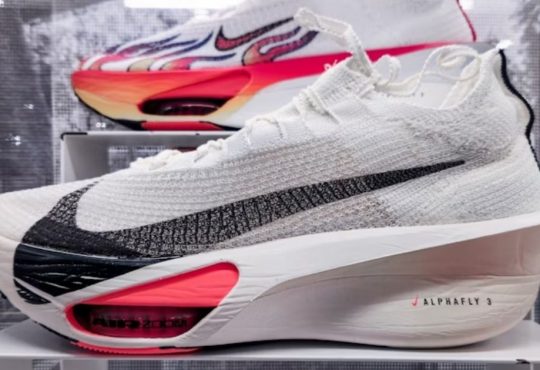Sneakers, once purely utilitarian, have transformed into one of the most iconic fashion statements of the modern era. Their evolution from athletic footwear to a cultural and streetwear staple has been nothing short of remarkable. What started as a tool for performance has now become a symbol of style, identity, and subculture, all while maintaining its original function. Let’s dive into how sneakers evolved from their humble beginnings to their current status as a global fashion phenomenon.
The Ultimate Sneaker Journey: 9 Defining Moments Every Fan Should Know
1. The Humble Beginnings: Athletic Footwear
Sneakers have a history that dates back to the late 19th century, beginning with the introduction of the first rubber-soled shoes. The original purpose of these shoes was strictly functional — to provide better traction for athletes. In 1892, the U.S. Rubber Company launched the first shoe designed specifically for athletes, which featured a rubber sole. By the early 20th century, the invention of canvas sneakers, such as the Converse Chuck Taylor All-Stars, helped solidify sneakers as the go-to footwear for basketball players and other sports enthusiasts.
During this period, sneakers were primarily seen on the playing field or in gyms, where they were valued for their comfort and performance. The widespread popularity of sneakers among athletes only grew in the mid-20th century as new brands like Adidas, Nike, and Puma began producing high-performance shoes designed to cater to specific sports. For years, sneakers remained mainly tied to sports, but their role was about to change.
2. The Rise of Sneakers in Pop Culture
The 1970s and 1980s were pivotal decades that elevated sneakers to a significant cultural status. The rise of hip-hop culture and the influence of iconic athletes like Michael Jordan introduced sneakers to a wider audience. Brands such as Nike, Reebok, and Adidas capitalized on this emerging trend by collaborating with musicians and athletes, creating sneakers that were as much about personal expression as they were about performance.
In 1985, Nike revolutionized the sneaker world with the release of the Air Jordan 1, a shoe designed specifically for basketball legend Michael Jordan. The shoe was groundbreaking not only in terms of performance but also in terms of marketing. It was a symbol of status, rebellion, and coolness, and it quickly became a must-have for both athletes and sneakerheads alike. The cultural cachet of sneakers began to grow, and their transition from sportswear to streetwear began to take shape.
3. Sneakers as Fashion Statements
By the 1990s and 2000s, sneakers had become a defining element of streetwear culture, cementing their status as both fashion staples and symbols of self-expression. Brands like Supreme, BAPE, and Off-White began creating limited-edition sneakers that attracted both fashion enthusiasts and sneaker collectors. The rise of “sneaker culture” brought exclusive drops and collaborations, turning each release into a highly anticipated event. For many, collecting sneakers became not only a hobby but also a lucrative business opportunity.
This period also saw the rise of the “sneakerhead” community, a group of passionate individuals who obsessively sought out rare and limited-edition sneakers. Online resale platforms like StockX and Stadium Goods further fueled this trend, making it easier for sneakerheads to buy, sell, and trade shoes. The streetwear movement, driven by influencers and designers, embraced sneakers as a way to mix comfort with high-end fashion, creating a fusion of luxury and casual wear that became the norm.
4. Sneakers in Today’s Fashion Landscape
Today, sneakers are deeply embedded in the fashion world, far beyond their roots as mere athletic footwear, effortlessly blending function with high style. High-end designers like Balenciaga, Gucci, and Louis Vuitton have incorporated sneakers into their collections, blurring the lines between performance and fashion. This crossover is further emphasized by collaborations between top sneaker brands and high-fashion labels, creating exclusive designs that are coveted by both sneakerheads and luxury consumers.
The influence of sneakers on daily style is nothing short of transformative, reshaping wardrobes and redefining what it means to dress with an edge. From the classic Converse Chuck Taylor to the futuristic design of the Adidas Yeezy, sneakers have become a symbol of both individuality and luxury. They are no longer just for the gym or the court—they’re worn with everything, from tailored suits to casual streetwear, embodying the blending of comfort and style that defines modern fashion.
5. Looking Ahead: Sneakers as a Form of Self-Expression
As sneakers continue to evolve, they remain an essential part of personal expression, allowing individuals to showcase their unique style, preferences, and cultural influences. Whether it’s customizing a pair of Vans with unique artwork or wearing the latest Nike collaboration, sneakers offer wearers a chance to showcase their personality, style, and social status. The future of sneakers seems boundless as they continue to be a vehicle for creative innovation, cultural expression, and athletic performance.
From their origins as humble athletic shoes to their status as a global fashion phenomenon, sneakers have transformed into something else. Today, sneakers represent far more than just something you wear on your feet—they’re powerful symbols of individuality, social status, and cultural influence. Whether you’re a seasoned sneakerhead or someone who simply appreciates the art of design, there’s no denying that sneakers have become a staple of everyday life. The evolution of sneakers is far from over, and their journey from sport to streetwear continues to shape the fashion landscape.
6. The Influence of Technology and Innovation
One of the key drivers behind the evolution of sneakers has been the continuous advancements in technology and material innovation. While sneakers found their place in lifestyle and fashion, performance upgrades never took a backseat. The integration of cutting-edge technologies, like Nike’s Flyknit, Adidas’ Boost cushioning, and Under Armour’s HOVR, transformed the sneaker market. These innovations not only improved comfort and performance for athletes but also made sneakers more desirable as a fashion accessory.
Flyknit, for instance, introduced a lightweight, breathable, and flexible material, which dramatically changed how sneakers were designed. The Boost cushioning system by Adidas, known for its superior comfort, made sneakers not just a fashion item but a performance-driven choice for people who demand more from their shoes, whether they’re running marathons or running errands.
Beyond comfort and performance, sneaker designs are now influenced by environmental sustainability. With eco-consciousness growing in the fashion industry, brands like Allbirds and Veja have emerged as leaders in sustainable sneakers, using recycled materials, natural fibers, and ethical production practices. These changes reflect a broader shift in consumer values, where the demand for stylish, functional, and environmentally responsible footwear is on the rise.
7. Sneakers as a Canvas for Art and Expression
One of the most exciting developments in the sneaker world is the increasing trend of sneakers as a medium for art and self-expression. The customization culture, which began as a grassroots movement among sneakerheads, has blossomed into a global phenomenon. The rise of DIY sneaker culture, alongside collaborations with visual artists, musicians, and designers, has made sneakers a canvas for personal expression. Whether it’s the intricate artwork seen on custom Air Force 1s or the bold designs seen in collaborations like the Nike x Off-White “The Ten” collection, sneakers have become a statement of identity.
Sneaker collaborations with famous artists like Kaws, Takashi Murakami, and Virgil Abloh (the late Off-White founder) have further elevated the sneaker from mere footwear to wearable art. These limited-edition releases often feature avant-garde designs that blur the lines between fashion, art, and commercial products. For collectors and fans alike, the appeal goes beyond function; it’s about owning a piece of art that tells a story and represents a movement.
8. Global Impact: Sneakers as a Cultural Force
The global reach of sneakers has also played a pivotal role in their transformation. In cities like New York, Tokyo, Paris, and London, sneakers are a key component of street style, reflecting the local identity while connecting to a wider, international movement. They symbolize more than just a fashion trend—they represent the convergence of music, sport, technology, and social movements.
The influence of hip-hop and basketball on sneaker culture, for example, remains strong. Hip-hop culture, particularly in the ’80s and ’90s, saw artists like Run DMC, LL Cool J, and Jay-Z wearing iconic sneakers, cementing their status as cultural icons. These artists helped propel sneaker brands like Adidas, Nike, and Puma into the mainstream, using their influence to make sneakers a symbol of urban culture. Similarly, the rise of sneaker endorsements from NBA superstars like Michael Jordan, Kobe Bryant, and LeBron James helped elevate sneakers to a level of cultural significance that transcends the court.
In many ways, sneakers have become a means of social mobility. For those on the cutting edge of fashion and streetwear, wearing the latest pair of sneakers has come to represent status, access, and belonging to a certain group or scene. Whether it’s the allure of owning a pair of limited-edition Air Jordans or the bragging rights associated with a rare Yeezy drop, sneakers are a currency in the global streetwear economy.
9. Sneakers in the Digital Age of Innovation
As the digital age advances, sneakers are incorporating new technologies that connect the physical and virtual realms. In recent years, sneaker brands have started experimenting with virtual reality (VR) and augmented reality (AR), enabling customers to try on shoes in a virtual space before making a purchase. This innovation proves especially beneficial for online shopping, where trying on shoes is not feasible.
Nike has already started integrating AR into its retail strategy, allowing customers to scan a shoe’s image with their smartphone to see how it will look on their feet in real time. Adidas and other brands have also jumped on board with virtual sneaker releases, offering exclusive digital versions of shoes that exist only in the virtual realm. These virtual sneakers have taken on a new cultural significance in the world of online gaming, digital art, and NFTs (non-fungible tokens), where sneakers are sold as digital assets that hold both aesthetic and investment value.
The rise of virtual sneakers marks a significant step in the ongoing fusion of fashion and technology. As fashion continues to evolve, the future of sneakers may be shaped not just by what is worn on the feet but also by how individuals express themselves in the digital realm.
A Lasting Impact on Fashion and Culture
Looking ahead, the future of sneakers seems poised for even greater evolution. With the rapid advancements in technology, sustainability, and digital integration, sneakers will continue to be at the forefront of both fashion and innovation. Expect to see more eco-friendly materials, cutting-edge designs, and collaborations that push the boundaries of art, culture, and sport. As the lines between performance and fashion continue to blur, sneakers will remain a symbol of creativity and self-expression, inspiring future generations to walk (or run) in their own stylish, unique way.
Sneakers have evolved far beyond their origins as athletic gear, becoming a defining element of modern culture. They are no longer just footwear; they serve as symbols of creativity, status, and style. As they continue to shape how individuals dress, express themselves, and engage with the dynamic fashion world, their influence is set to endure, leaving a lasting impact on trends and personal expression for years to come.





